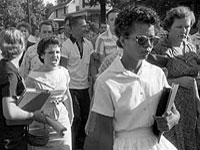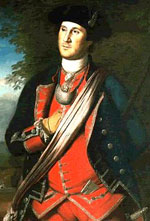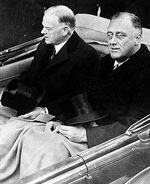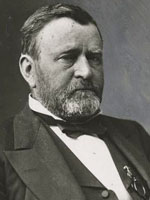If Abraham Lincoln Had an iPod
To celebrate Presidents Day, NPR classical music commentator Miles Hoffman explores the 16th president's musical tastes, as well as what music Lincoln might have chosen for his iPod, had he owned one.
To celebrate Presidents Day, NPR classical music commentator Miles Hoffman explores the 16th president's musical tastes, as well as what music Lincoln might have chosen for his iPod, had he owned one.
Celebrate President's Day with a free, framed, replica of Rembrandt Peale's Porthole Portrait of George Washington from the Mount Vernon historic site. It is specially sized (30”x36”) to take a place of honor in your school’s central office, library, or auditorium. Accompanying the portrait will be a George Washington Celebration Kit with suggested activities to commemorate the dedication of the portrait, as well as suggested lesson plans for classroom use.
To receive this FREE limited-edition portrait, please send a letter on school letterhead from the principal to Ann Bay, Associate Director for Education, George Washington’s Mount Vernon Estate & Gardens, P.O. Box 110, Mount Vernon, VA 22121. The letter should state 1) the space where the portrait will be hung; and 2) the school’s street address for UPS delivery. For further information, visit George Washington's Mount Vernon.

This collection of newspaper articles and photographs from two Arkansas newspapers explores the 1957 crisis in the city of Little Rock. National attention focused on the city when Governor Orval Faubus refused to allow nine African American students to desegregate the city's all-white Central High School, despite federal court rulings to the contrary. In response, President Dwight D. Eisenhower reluctantly became the first president since Reconstruction to send federal troops to protect the rights of African Americans.
Materials include news articles and editorials from each day of the month-long crisis, articles on the anniversaries from 1997 to 2000, and 16 photographs. In addition, material on the 40th anniversary of the crisis is provided: 19 op-ed pieces, speeches, an interview with President Clinton, timelines, and a 1991 defense by Faubus of his actions.

February 16 is Presidents Day—but what exactly does that mean? Even though it's a federal holiday, Presidents Day actually doesn't exist. It's officially still named George Washington's Birthday. The observance of Washington's birthday on February 22 began in 1880 (or 1885, depending on where you lived), but in 1971 the celebration changed to the third Monday in February. The chronological proximity of Abraham Lincoln's birthday on February 12 (never an official federal holiday), state mandates to combine the observance with recognition of other presidents,—even a push from commercial interests to call the day Presidents Day in order to have retail sales promotions—all led to the unofficial name, Presidents Day.
An unquantifiable number of excellent web resources exist for teaching about individual presidents and the presidency in general from presidential libraries to historic sites, to the National Archives and Library of Congress—to highlight perhaps the most familiar—however, several are listed below as supplemental "quick fixes."
White House 101: Facts and Fun for All Ages offers a comprehensive look at the presidency, from biographical slide shows and essays, to a briefing room with a blog of current events and commentary to a look at the categorized agenda of the Obama administration—and of course, a look at the White House and its history.
Constitutional Rights Foundation considers Presidents Day in 2009 as a time for reflection. The site looks at 13 presidents and key decisions and events from each administration from Washington to Lyndon Johnson. The initial article on George Washington, What Made George Washington a Great Leader, also lists the 10 best and 10 worst presidents, voted by 846 historians in 1983. Compare that with a recent C-span survey.

The anniversary of the October stock market crash of 1929 approaches, and many are comparing the current financial crisis to the beginning of the Great Depression. Here are some classroom resources for teaching about economic issues and commentary by historians on similarities and differences between 1929 and now.
Annenberg Media's Learner.org offers teacher resources to guide classroom discussion. Economics U$A looks at critical issues in U.S. economics, with programs including The Banking System, The Federal Reserve, Stabilization Policy, Exchange Rates. The program "Reducing Poverty" looks at policies enacted under FDR during The Great Depression. Inside the Global Economics looks at vivid examples around the world, from hyperinflation in Argentina to petrodollar recycling in the 1970s to "shock therapy" in Poland.
The Economics Classroom: A Workshop for Grade 9-12 Teachers includes programs relevant to the current crisis such as The Government's Hand and The Building Blocks of Macroeconomics.
In The Real Great Depression published in the Chronicle of Higher Education, 19th-century historian Scott Reynolds Nelson explains why the global Depression of 1873 offers a better historic parallel for the current financial crisis than does the crash of 1929.
Rutgers Professor James Livingston writes in The Great Depression and Ours: Part I at the History News Network that the present economic crisis and the Great Depression are comparable "not because they resulted from similar macroeconomic causes but because the severity of the credit freeze in both moments is equally great, and the scope of the financial solution must, then, be equally far-reaching." He discusses causal factors of both.
On The New York Times Video Reports an economic reporter and the Chief Financial Correspondent talk about the roots of the crisis and compare it to the Great Depression. Their conversation, Echoes of a Dismal Past explores whether the government has learned the lessons of the 1930s. Financial Crisis Hits Teens goes to Elisabeth Irwin High School in downtown Manhattan to see how the nation's financial crisis is trickling down to teenagers. The three-and-half minute video offers a good starting point for economics, history, and social studies classroom discussion.
Professor Lucas E. Morel reviews the life and views of Martin Luther King, Jr., focusing on the March on Washington and King's "I Have a Dream" speech. This lecture continues from the lecture Martin Luther King, Jr., Part One.
For the lecture, scroll down to the third seminar of Wednesday, August 4. Readings, available for download, accompany the lecture.
An older version of this lecture can be found here.
John Lloyd of California State Polytechnic University examines important documents in U.S. history, including the U.S. Constitution and documents related to abolitionism and nullification, in order to establish a context for the Civil War.
Idaho State University Political Science Professor David Gray Adler examines what he describes as the great constitutional crisis of the day: the usurpation and abdication of constitutional roles by President and Congress. Building his argument on the concerns of the Framers, Dr. Adler points to the endangerment to liberty posed by the erosion of checks and balances.
Audio and video options are available.
David Eisenhower of the Foreign Policy Research Institute considers the current necessity of approaching terrorism and the current war as teaching subjects, and looks at how national crises—such as 9/11—pose certain rhetorical and leadership demands on presidents, and how President Bush reacted to these demands.
Video and audio options are available.

When was the number of Supreme Court Justices expanded to nine, and what was the reason? Why wasn't there a large public uproar like the one FDR experienced?
On April 10, 1869, Congress passed an act to amend the judicial system in part by increasing the number of Supreme Court justices to nine, to take effect the first Monday in December of that year. That act, which remains in effect to this day, by itself did not provoke a public outcry. A mostly partisan-based controversy did arise, however, when the votes of two new justices nominated by President Ulysses S. Grant in February 1870 and confirmed by the Senate resulted in the overturning of a recent politically divisive court decision.
Grant was accused with packing the court, the same charge leveled against FDR in 1937 when he put forth a plan to reform a Supreme Court that repeatedly had judged key New Deal and state reform legislation to be unconstitutional. Roosevelt proposed giving the President the opportunity to nominate one new justice to the Court whenever a sitting justice who had been on the Court for at least 10 years and had not retired within six months of turning 70 years of age—the average age of the justices at the time was 71—with a maximum total of six such appointments to be allowed. In a fireside chat in March, Roosevelt cited as precedent a bill passed by the House of Representatives in March 1869 that had proposed adding a justice to the Court whenever a sitting justice reached the age of 70 with no upper limit specified for the number of justices the Court could have. Roosevelt's plan was vigorously opposed even by many of the President's supporters.
On six occasions prior to the April 1869 act, Congress had enacted legislation to change the number of Supreme Court justices. The April 1869 legislation—passed without the inclusion of the controversial provision in the March House bill that FDR had cited as a precedent—in effect repealed a July 1866 law stipulating that vacancies for associate justices would not be filled until the total number of justices reached seven. Many scholars of the Court have circulated the view that Radical Republicans in Congress passed the 1866 act—which in turn, in effect, had repealed an 1863 act that had increased the number of justices to 10—to take away President Andrew Johnson's power to appoint conservative justices. Once Grant was elected to the presidency, according to this view, Congress increased the number of justices to nine to give their party more sway over the Court's decisions.
Historian Stanley I. Kutler persuasively has challenged part of this interpretation, arguing that evidence is lacking to support the claim that Republicans "primarily sought to avoid a Johnson appointment." Among other arguments, Kutler points out that Johnson himself approved the 1866 bill and that the 1869 bill was passed by Congress before Johnson left office. Kutler contends that both Congress and Johnson believed that the Court had become unwieldy with too many justices. Still, the main intent of the legislation, which included a reorganization of the judicial circuit system, was to reduce Southern influence on the judiciary, Kutler concludes.
Less than one year after Grant's nominees to the Court assumed office, the Court, by a vote of five to four, overturned the four to three opinion in Hepburn v. Griswold that had ruled three legal tender acts of 1862 and 1863 to be invalid, one of the first times that the Court had judged Congressional legislation to be unconstitutional. The acts, instituted to help pay for the war, had authorized the federal government to issue paper money, colloquially known as "greenbacks" as legal tender that would be irredeemable in specie, i.e. gold or silver coins. Political controversy had arisen after rampant inflation had driven down the value of greenbacks drastically and the question arose as to whether creditors could demand payback for debts in coins or would have to accept paper currency. Those who supported the legal tender acts believed that the Hepburn ruling would result in a contraction of the money supply that would hurt many ordinary Americans in debt. Those in support of Hepburn worried that public debt had risen greatly because in borrowing money, the federal government had been at the mercy of foreign governments that had remained on the gold standard. Defenders of Hepburn also charged that its reversal had been instigated at the behest of big business, as the New York Sun wrote, "so that the great corporations might pay their debts in depreciated paper, instead of coin."
On the day that the Hepburn ruling was announced, February 7, 1870, Grant, who favored upholding the legal tender acts, sent two nominations for new Supreme Court justices to the Senate for confirmation. Previously, one nominee, William Strong, as a judge on the Pennsylvania Supreme Court, had ruled to uphold the legal tender acts, and many suspected that the other nominee, Joseph P. Bradley, had vowed he would vote to validate the acts. The ruling to overturn Hepburn and the suspicion that Grant had packed the court caused much adverse comment in the press. The New York Tribune charged, "Powerful corporations, wielding large political and moneyed influence, are deeply involved in the question. . . . The decision, therefore, injures the poor many, and puts immense sums in the pockets of the rich and flourishing few corporations."
Many critics noted Strong's and Bradley's previously ties to railroads. The New York Bulletin bemoaned, "We have now learnt, for the first time, that a President can pack the supreme tribunal of the land, and its Judges can recognize other considerations than those of law and justice. . . . Of all calamities since the foundation of the republic, this is the saddest and the most bitterly wounding to high-minded citizens." The Chicago Tribune similarly lamented, "Nothing has occurred in the history of the country, except, possibly, the Dred Scott decision, so calculated to impair confidence in the stability of the court and the permanency of the republic as this action. . . . The country could survive rebellion, but it cannot outlive the destruction of credit, and the abolishment of the judicial branch of the government."
During the 1872 presidential campaign, Grant's opponents repeated the accusation that he had packed the court with justices who had promised to overturn Hepburn. The controversy was revived periodically until 1935, when Sidney Ratner, later to become a renowned economic historian, presented evidence from the unpublished diary of Grant's Secretary of State, Hamilton Fish, that Grant "required no declaration from Judges Strong and Bradley on the constitutionality of the Legal Tender Act." Fish revealed, however, that Grant did know of Strong's previous ruling and "had reason to believe Judge Bradley's opinion tended in the same direction." While Grant had assured Fish that "he would do nothing to exact anything like a pledge or expression of opinion from the parties he might appoint to the Bench," the president "had desired that the Constitutionality [of the Legal Tender Act] should be sustained by the Supreme Court." Ratner argued that because Grant had not explicitly requested his nominees to decide in favor of Hepburn, "it is not just to say that he 'packed the Court', or that the new judges were 'creatures of the President placed upon the Bench to carry out his instructions.'" A New York Times obituary of Ratner indicated that he had been "influential in President Franklin D. Roosevelt's attempt to expand the size of the Supreme Court by discovering a precedent in President Ulysses S. Grant's appointments to the Court."
"The Legal-Tender Decision," Chicago Tribune, 27 April 1871, 29 April 1871 [which reprints New York Tribune and New York Bulletin editorials].
Edward S. Corwin, "Curbing the Court," Annals of the American Academy of Political and Social Sciences 185 (May 1936).
Kenneth W. Dam, "The Legal Tender Cases," Supreme Court Review 1981 (1981).
Charles Fairman, Reconstruction and Reunion, 186488, History of the Supreme Court of the United States. Vol. 6, pt. 1. New York: Macmillan, 1971.
Stanley I. Kutler, "Reconstruction and the Supreme Court: The Numbers Game Reconsidered," Journal of Southern History 32 (Feb. 1966).
William E. Leuchtenburg, The Supreme Court Reborn: The Constitutional Revolution in the Age of Roosevelt. New York: Oxford University Press, 1995.
Lawrence W. Levine and Cornelia R. Levine, The People and the President: America's Conversation with FDR. Boston: Beacon Press, 2002.
Alpheus Thomas Mason, "Politics and the Supreme Court: President Roosevelt's Proposal," University of Pennsylvania Law Review and American Law Register 85 (May 1937).
Scholar Specialized in Economic History," New York Times, 17 January 1996.
Sidney Ratner, "Was the Supreme Court Packed by President Grant?" Political Science Quarterly 50 (September 1935).